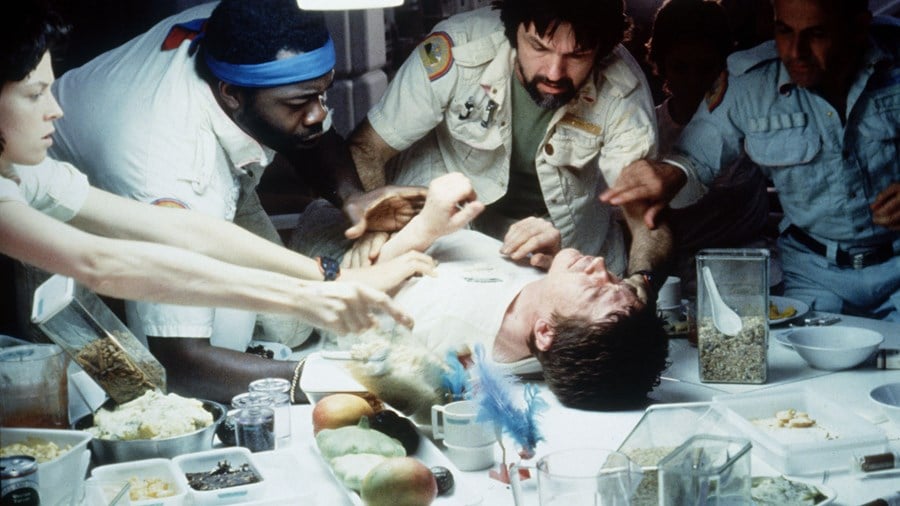Ahead of Alien: Romulus, Sean Wilson considers how the film series’ music has mutated alongside its titular xenomorphs to deftly communicate the sci-fi saga’s elemental horror.

Mutability lies at the heart of the Alien franchise. This is a series that’s constantly evolving, both in subject (with narratives detailing the parasitic corruption of the human body) and style (as multiple directors put their stamp on the material). Akin to the alien itself, the franchise has grown from the relatively humble beginnings of Ridley Scott’s Alien (1979) into an outsized, multi-stranded monster of a saga – and music has been pivotal to this development.
Noted horror composer Benjamin Wallfisch scores the latest film in the series, Alien: Romulus. In the manner of his acclaimed themes for Lights Out (2016), and It: Chapters One (2017) and Two (2019), Wallfisch’s Alien: Romulus score alternates between lyricism and brutality. Graceful melodies have long been associated with human vitality and warmth. Here, the poeticism is undercut by erratic time signatures and harsher musical effects, suggesting that more animalistic, bestial impulses are threatening humanity. This is in line with the themes of the film, as a group of space colonists discover their biological and emotional identity is under threat from the horrifying xenomorph.

Wallfisch’s approach is very much in keeping with the existing musical principles of the series, starting with Jerry Goldsmith’s score for Alien. Goldsmith was already established as a sci-fi innovator following his groundbreaking work on Planet of the Apes (1968), which shook the scoring industry to its core with an onslaught of atonal bowls and ram’s horn effects. The same year that he composed Alien, Goldsmith would define the tone of another sci-fi monolith in the form of Star Trek: The Motion Picture (1979), replete with its brassily propulsive main theme and eerily discordant effects from the electronic blaster-beam instrument.
Goldsmith was therefore seen as a major boon to the production. To create Alien’s score, he took his lead from xenomorph designer HR Giger’s horribly impressive prototypes, which were directly inspired by the artist’s 1976 painting Necronom IV, a ‘biomechanical’ work where recognisable humanity and mechanised horror hellishly collide. For his part, Goldsmith builds from a haunting trumpet theme, drawing connotations of colonial expanse and human endeavour (the instrument, for example, was used for bugling in the American Civil War). Yet all the while the theme is underscored by a subtle, icy tension. It’s an effective musical match for the film’s famous tagline, ‘In space, no one can hear you scream’. The music is leading us into the unknown with a mixture of wonder and disquiet.

Alien (1979)
The innovative Goldsmith then offsets these melodic textures against those representing the alien itself. This includes the serpent: an archaic, 16th-century wind instrument that scuttles and slithers and audibly personifies a horrific, rapidly growing biological organism. Pizzicato strings are placed through a device called the echoplex, allowing repetitious musical phrases to gradually dissipate within the aural landscape, and create a cavernous unease. This is ably demonstrated in the famous sequence when the crew of the Nostromo lands on LV-426 to discover the derelict alien spacecraft and the ‘space jockey’ skeleton before stumbling upon the xenomorph eggs. The music conveys a sense of physical and psychological disintegration in the face of the great unknown before the end titles reinstate the main theme in a glorious major key, signalling Ellen Ripley’s (Sigourney Weaver) triumph in defeating the alien.
At least, that was the original intention. Goldsmith’s work was badly truncated by Scott and editor Terry Rawlings to the extent that his main theme was minimised in the final cut, and other cues were replaced wholesale by different works. Tracks from Goldsmith’s own score for Freud (1962) replaced his original cue for the air-shaft pursuit and the facehugger leaking acid blood through the hull, while the proposed ‘End Title’ gave way to Howard Hanson’s ‘Symphony no. 2, Op. 30 “Romantic”’. Needless to say, Goldsmith wasn’t satisfied, and his travails on Alien set in motion a pattern of tumultuous scoring sessions on the later films.

Alien (1979)
The franchise mutated in the transition from Alien to Aliens (1986), directed by James Cameron. Where Ridley Scott’s original was a claustrophobic horror, the sequel was a combat-heavy war movie, with the surviving Ripley leading a group of space marines to battle the remnant aliens on LV-426, the planet where the xenomorph eggs were first discovered. Cameron’s militaristic approach informed James Horner’s terse and suspenseful score.
If Jerry Goldsmith planted the musical seeds of the franchise, then Horner’s ensuing score produced sharp, staccato action rhythms. The composer, then in the relative infancy of his career, built on the propulsion of his acclaimed score for Star Trek II: The Wrath of Khan (1982), employing brutally avant-garde brass and string passages mixed with pounding anvil arrangements to drive home Ripley’s climactic battle with the alien queen. Tracks such as ‘Bishop’s Countdown’, which later featured prominently in 1990s movie trailers like Broken Arrow (1996) and Dante’s Peak (1997), demonstrate this perfectly.

Aliens (1986)
The relentless tone of Horner’s score was likely the result of a truly horrendous scoring process. Horner’s time to write and record the score with the London Symphony Orchestra was cut down from six weeks to three because the shooting schedule had fallen behind. The composer received little sympathy from Cameron and producer Gale Anne Hurd, who forced frequent last-minute cue changes on the recording sessions (the aforementioned ‘Bishop’s Countdown’ was famously composed overnight). Although Horner’s score was Oscar-nominated and, like Goldsmith’s work on Alien, is now seen as a pivotal part of the film’s fabric, at the time it felt like a pyrrhic victory. (Ironically, the rushed schedule also caused Goldsmith’s compromised score to be worked into the final sound mix of Aliens.)
Post-Aliens, the saga’s musical aesthetic continued to evolve in line with the films themselves. David Fincher’s gloomy and grisly Alien 3 arrived on the big screen in 1992, having found itself mired in production problems. Composer Elliot Goldenthal’s score is distinguished by striking aleatoric writing – essentially, improvised passages of music that intentionally blur the lines between subjective music and objective sound design.

Aliens (1986)
The score was influenced by both a nightmarish post-production schedule and the overhanging influence of the Rodney King race riots that occurred during the recording process. All the better for matching the bleak prison landscape of Fury-161, but Goldenthal also delivers some of the most beautifully impassioned moments in the series. These sequences are frequently led by haunting soprano vocal arrangements, and Goldenthal ultimately fashions a string-led elegy for Ellen Ripley (titled ‘Adagio’) as she makes the ultimate sacrifice to defeat the xenomorph inside her own body. Goldenthal’s score established the mixture of romanticism and brutality that would later define his work on films such as Interview with the Vampire (1994) and Michael Collins (1996).
In the eyes of fans, Alien: Resurrection (1997), directed by Jean-Pierre Jeunet, was a disappointing climax to the original quadrilogy, awkwardly sandwiched between grotesque body horror and a semi-flippant survival adventure. Of all the movies in the series, it makes the greatest concessions to the mainstream and it’s little surprise that John Frizzell’s score is perhaps the most conventional in its construction. That said, it’s still a powerful work, structured around a singular, brooding theme that is aligned with the otherworldly human/alien Ellen Ripley clone at the heart of the narrative. The theme regularly gives way to frantically raucous orchestral interludes that signal the eruption of a new xenomorph infestation 200 years after the events of Alien 3.

Alien: Resurrection (1997)
Thematic music writing has remained central to the Alien franchise, even as it has spiralled into backstory. The fifth instalment in the Alien franchise, Ridley Scott’s prequel Prometheus (2012), depicts a deep-space crew’s search for our human ancestors, which rapidly intersects with the nascent xenomorph lifecycle to grisly effect. Scott employed his regular musical collaborator Harry Gregson-Williams, with whom he had worked on Kingdom of Heaven (2005), to compose a noble, awestruck theme called ‘Creation’. It’s very much in keeping with Jerry Goldsmith and captures the grandiosity of the narrative. The bulk of the score was written by composer Marc Streitenfeld, another Scott collaborator from American Gangster (2007), whose aggressively avant-garde horror writing owes more to Elliot Goldenthal’s work on Alien 3.
Gregson-Williams’ theme appears diegetically on a recorder arrangement in Scott’s follow-up film Alien: Covenant (2017). Of greater note is the recurrence of Jerry Goldsmith’s rejected ‘Main Title’ treatment for Alien, here given a reworking by Alien: Covenant composer Jed Kurzel to spine-tingling effect during the film’s opening titles. One senses Scott was making amends for his treatment of Goldsmith’s work all those years ago. Like the alien itself, the music for the saga comes full circle to reestablish a sense of gnawing horror, gradual unease and unexpected beauty – contradictory elements that continue to affect listeners the world over.
WATCH ALIEN: ROMULUS IN CINEMAS




